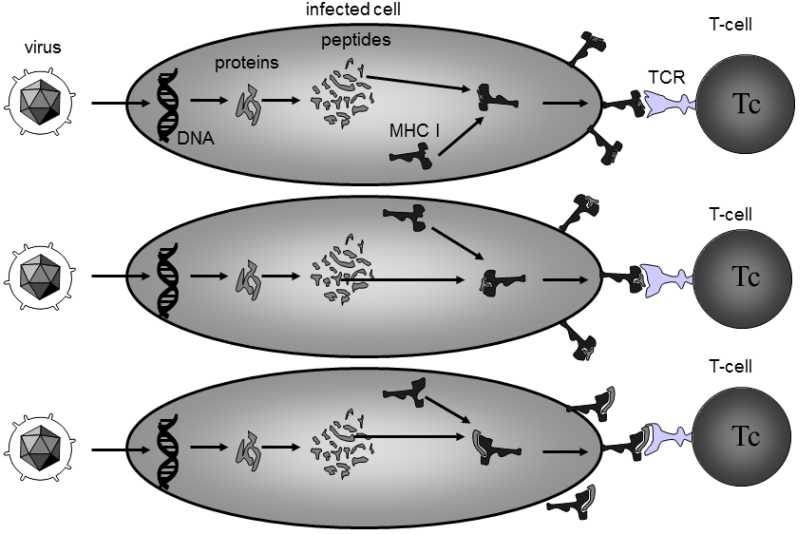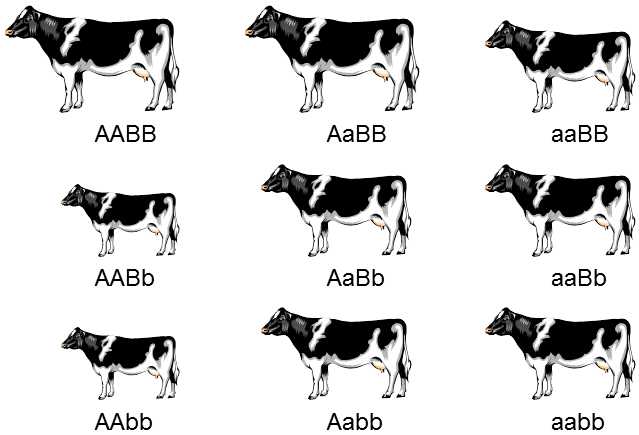VIII.4.3.1 Polymorphism of MHC-antigens seems to be maintained by frequency-dependent selection, not by selection for heterozygotes.
An interesting example of the action of frequency-dependent selection is active in maintenance of polymorphism of the major histocompatibility complex antigens (MHC-antigens) (Klein & Ohuigin 1994).These proteins are of key importance in both cell and humoral immunity processes.They specifically bond, on their receptor region, some of the short peptides formed in the cells by enzymatic splicing of protein molecules and transport them to the cell surface. In this way, they determine the sections of the aminoacid chain according to which the immune system of the given individual will recognize the foreignness of a particular protein.If all the individuals in the population were identical in their MHC-antigen alleles, they would recognize the foreignness of the individual antigens, e.g. proteins derived from viruses and bacteria, according to the same criteria, i.e. according to the same sections of the aminoacid chain.In typical cases, evolution occurs much more rapidly amongst parasitic organisms than in their hosts. Thus, a parasite would be capable of rapidly changing the relevant site of its proteins, which would remove it from the action of the immune system of the host and it would be capable of attacking all the individuals in the host population.However, MHC-antigens are extremely polymorphic in real populations.Each MHC gene (MHC is a complex consisting of several genes) has a number of alleles (frequently dozens) that occur with quite similar frequencies in the population.For most species, with the exception of identical twins, it is thus not possible to find two individuals that would have the same combination of alleles of the major histocompatibility complex.
This extreme polymorphism was not formed to teach transplantation surgeons humility (without MHC polymorphism, some organs could be transplanted on an extensive scale) but as a defensive strategy of organisms against parasites.The individual alleles of MHC antigens specifically bind different peptides (Fig. VIII.9).Because every individual in the population has different MHC alleles, it

Fig. VIII.9. The importance of MHC-polymorphism. If a virus penetrates into the cell and begins to synthesize its proteins there, part of these proteins, similar to part of all the proteins of attacked cell, will be digested by a special proteolytic apparatus into peptides, usually with a length of 6-9 aminoacids. Directly in the cell, a certain subset of these peptides is specifically bound to the first class MHC-proteins present, transported with them to the cell surface and presented to the T-cells there. If the body of the organism has a cytotoxic T-cell capable of recognizing any of the presented peptides through its unique T-cell receptor (TCR), it kills the cell presenting the given peptide and thus destroys the particular virus. The clone of the T-cell with the relevant receptor also multiplies in the individual, ensuring immunity against this virus in the future. The body of a healthy individual does not contain any T-cells with receptors capable of bonding to peptides formed by digesting the body’s own proteins, as these T-cells are constantly removed during their development in the thymus. As the individual variants of MHC-proteins bond different subsets of peptides, various individuals in the population recognize the same virus proteins on the basis of their different peptides. Consequently, a virus or some other parasite cannot adapt to the population of the host through an evolutionary process(by elimination of recognized peptides from its proteins), if the latter is sufficiently polymorphic in its MHC-proteins. In an experiment, this fact is manifested, e.g. as MHC-restriction, i.e. a phenomenon that originally substantially contributed to the discovery of MHC-proteins.s If T-cells are isolated from individuals immunized against a certain virus and these are allowed to react in a tissue culture with foreign cells infected with the same virus, the foreign cells will be killed only if they are derived from an individual bearing the same MHC-protein variant. In other cases, the foreign cells present, on their surface, a subset of peptides that the T-cells in the original animal never encountered, so that the clones of the T-cells with the relevant TCR were not multiplied in the immunized individual.
recognizes the foreignness of the parasite proteins according to different sections of their aminoacid chain.Thus, the parasite cannot mutate the sequence of its proteins in a manner that would allow it to successfully attack all the individuals in the host population.The evenness of the frequency of the individual alleles of the MHC genes is apparently ensured by a frequency-dependent selection mechanism.If the frequency of certain alleles increases in the population, the individuals in the parasite population that mutated in that area of their proteins that was originally specifically bonded to the MHC-antigen coded by the particular frequent allele begin to have a selection advantage in the parasite population.Thus, individuals that, through mutations, have removed, from their proteins, sites capable of binding to the commonest MHC-antigen and that can thus not be recognized by the immune system of the host begin, in time, to predominate in the parasite population.Consequently, the parasite will multiply most successfully in individuals bearing the commonest MHC-allele.As a result, these individuals will be affected most and their frequency and the frequency of the relevant allele will decrease.
In many species, including man, the maintenance of polymorphism in MHC genes is also strengthened with different mechanisms, by assortative reproduction.For example the fertility of partners with different MHC alleles is in average higher than that the partners with higher representation of same MHC alleles in genotype.It is partly caused by higher frequency of abortion of embryos homozygous in one or more genes of MHC [11567].
For a long time, immunologists discussed the question of whether the polymorphism of MHC-antigens is maintained in the population through the action of frequency-dependent selection or through the action of selection for heterozygotes.At the present time, it tends to be accepted that frequency-dependent selection plays the main role [10738].The usual argument is that, if selection for heterozygotes were the main factor, it would be much more advantageous for the organism to increase the number of loci for MHC-antigens and thus the number of various kinds of MHC-antigens located on the surface of one cell, than to increase the number of alleles in a constant, not very large number of loci.However, the problem is somewhat more complicated (Takahata 1995).The number of various molecules of MHC-antigens on a single cell may, in actual fact, be limited from above by the necessity of eliminating all the T-cells that recognize an organism’s own peptide capable of binding one of its own MHC-molecules, during development of the lymphocytes in the thymus.Individuals with a large number of variants of MHC-molecules on the surface of their cells could thus have a substantially reduced range of T-cells and thus much worse immunity. Although it is more advantageous for the population as a whole to exhibit the greatest possible polymorphism of MHC molecules, there is a certain optimal number of MHC-alleles for individuals that, when exceeded, would lead to substantial reduction in the range of T-cells and thus to reduction in the ability to recognize the presence of foreign agents in the organism.It is apparently more advantageous for individuals to bear the less common variants of MHC-antigens than to bear the greatest number of these variants, i.e. to be heterozygote in the greatest possible number of loci.However, this once again indicates that polymorphism in MHC-antigens will tend to be a consequence of the action of frequency-dependent selection rather than selection for heterozygotes.

Fig. VIII.10. Maintenance of polymorphism as a consequence of epistatic interaction. The size of the animal in the figure corresponds to its fitness, e.g. the probability that a breeder will keep it for breeding. In the depicted hypothetical case, individuals with genotypes AABB and AaBB, i.e. bearers of A alleles, have the highest fitness, where these genotypes do not have a single b allele in the second locus. In the presence of b alleles, on the other hand, the bearers of at least one a allele have the highest fitness. If the presence of alleles B and b is maintained in the gene pool for some reason, the presence of both alleles A and a will be permanently maintained in the gene pool as a consequence of the above-described epistatic interactions. However, on the basis of genetic (and economic) considerations, a breeder could decide to include in the breeding only individuals with genotype aa, as they do not produce individuals with extremely low fitness in the population.
